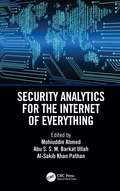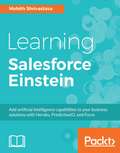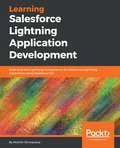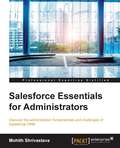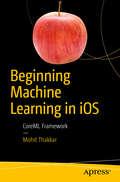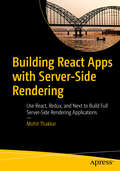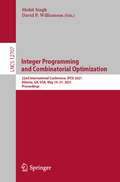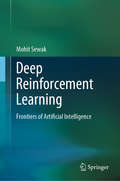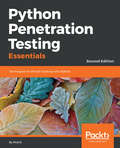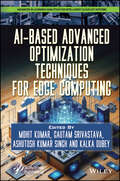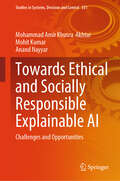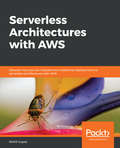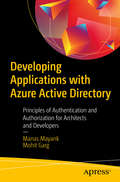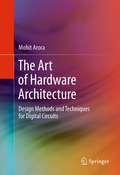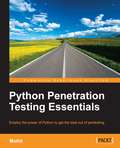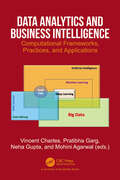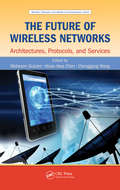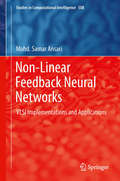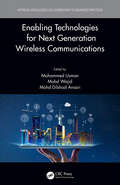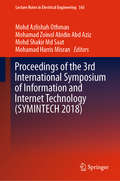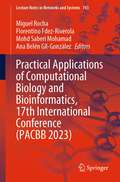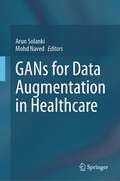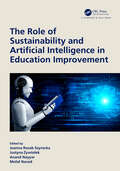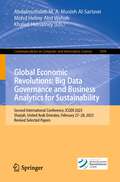- Table View
- List View
Security Analytics for the Internet of Everything
by Al-Sakib Khan Pathan Mohiuddin Ahmed Abu S. S. M. Barkat UllahSecurity Analytics for the Internet of Everything compiles the latest trends, technologies, and applications in this emerging field. It includes chapters covering emerging security trends, cyber governance, artificial intelligence in cybersecurity, and cyber challenges. Contributions from leading international experts are included. The target audience for the book is graduate students, professionals, and researchers working in the fields of cybersecurity, computer networks, communications, and the Internet of Everything (IoE). The book also includes some chapters written in a tutorial style so that general readers can easily grasp some of the ideas.
Learning Salesforce Einstein
by Mohith ShrivastavaIncorporate the power of Einstein in your Salesforce application About This Book • Make better predictions of your business processes using prediction and predictive modeling • Build your own custom models by leveraging PredictionIO on the Heroku platform • Integrate Einstein into various cloud services to predict sales, marketing leads, insights into news feeds, and more Who This Book Is For This book is for developers, data scientists, and Salesforce-experienced consultants who want to explore Salesforce Einstein and its current offerings. It assumes some prior experience with the Salesforce platform. What You Will Learn • Get introduced to AI and its role in CRM and cloud applications • Understand how Einstein works for the sales, service, marketing, community, and commerce clouds • Gain a deep understanding of how to use Einstein for the analytics cloud • Build predictive apps on Heroku using PredictionIO, and work with Einstein Predictive Vision Services • Incorporate Einstein in the IoT cloud • Test the accuracy of Einstein through Salesforce reporting and Wave analytics In Detail Dreamforce 16 brought forth the latest addition to the Salesforce platform: an AI tool named Einstein. Einstein promises to provide users of all Salesforce applications with a powerful platform to help them gain deep insights into the data they work on. This book will introduce you to Einstein and help you integrate it into your respective business applications based on the Salesforce platform. We start off with an introduction to AI, then move on to look at how AI can make your CRM and apps smarter. Next, we discuss various out-of-the-box components added to sales, service, marketing, and community clouds from salesforce to add Artificial Intelligence capabilities. Further on, we teach you how to use Heroku, PredictionIO, and the force.com platform, along with Einstein, to build smarter apps. The core chapters focus on developer content and introduce PredictionIO and Salesforce Einstein Vision Services. We explore Einstein Predictive Vision Services, along with analytics cloud, the Einstein Data Discovery product, and IOT core concepts. Throughout the book, we also focus on how Einstein can be integrated into CRM and various clouds such as sales, services, marketing, and communities. By the end of the book, you will be able to embrace and leverage the power of Einstein, incorporating its functions to gain more knowledge. Salesforce developers will be introduced to the world of AI, while data scientists will gain insights into Salesforce's various cloud offerings and how they can use Einstein's capabilities and enhance applications. Style and approach This book takes a straightforward approach to explain Salesforce Einstein and all of its potential applications. Filled with examples, the book presents the facts along with seasoned advice and real-world use cases to ensure you have all the resources you need to incorporate the power of Einstein in your work.
Learning Salesforce Lightning Application Development: Build and test Lightning Components for Salesforce Lightning Experience using Salesforce DX
by Mohith ShrivastavaBuild, design, and style beautiful and informative applications on the Salesforce Lightning platformKey FeaturesBuild and Test Lightning Components that enhance application usability and adaptabilityApply Security Best Practices to your Custom Lightning ComponentsDesign Lightning Components for Salesforce UIs such as Lightning Pages, Salesforce 1 Application, Communities, and more.Book DescriptionBuilt on the Salesforce App Cloud, the new Salesforce Lightning Experience combines three major components: Lightning Design System, Lightning App Builder, and Lightning Components, to provide an enhanced user experience. This book will enable you to quickly create modern, enterprise apps with Lightning Component Framework.You will start by building simple Lightning Components and understanding the Lightning Components architecture. The chapters cover the basics of Lightning Component Framework semantics and syntax, the security features provided by Locker Service, and use of third-party libraries inside Lightning Components. The later chapters focus on debugging, performance tuning, testing using Lightning Testing Services, and how to publish Lightning Components on Salesforce AppExchange.What you will learnUnderstand Lightning Components architecture Learn Locker security best practices Debug and Improve performance of your Lightning Components Use third-party libraries along with Lightning Component FrameworkLearn how to publish Lightning Components on AppExchangeUse Lightning Out to take your Lightning Components outside the Salesforce platformWho this book is forThis book is for Salesforce developers or developers from other platforms who are familiar with HTML, CSS, and JavaScript and want to build and test Salesforce Lightning components. No knowledge of Salesforce Lightning is required.
Salesforce Essentials for Administrators
by Mohith ShrivastavaThis book is targeted at expert administrators or professionals who are new to Salesforce and want to learn the various features supported by the platform in a short space of time. The book can also be used by professionals preparing for Developer and Administrator certification exams from Salesforce.
Beginning Machine Learning in iOS: CoreML Framework
by Mohit ThakkarImplement machine learning models in your iOS applications. This short work begins by reviewing the primary principals of machine learning and then moves on to discussing more advanced topics, such as CoreML, the framework used to enable machine learning tasks in Apple products. Many applications on iPhone use machine learning: Siri to serve voice-based requests, the Photos app for facial recognition, and Facebook to suggest which people that might be in a photo. You'll review how these types of machine learning tasks are implemented and performed so that you can use them in your own apps. Beginning Machine Learning in iOS is your guide to putting machine learning to work in your iOS applications.What You'll LearnUnderstand the CoreML componentsTrain custom modelsImplement GPU processing for better computation efficiencyEnable machine learning in your application Who This Book Is ForNovice developers and programmers who wish to implement machine learning in their iOS applications and those who want to learn the fundamentals about machine learning.
Building React Apps with Server-Side Rendering: Use React, Redux, and Next to Build Full Server-Side Rendering Applications
by Mohit ThakkarLeverage the benefits of both client-side and server-side rendering to get the most out of your React applications. By the end of this book you will be able to build and deploy React applications using the Next.js framework to fully render server-side HTML on every Web page. You'll begin by reviewing JavaScript fundamentals and how they work with the core principles of React. You'll then move on to Next.js, the React framework for server-rendered applications. Using this framework, you will create a fast and secure solutional React application that renders content on the server-side, protects sensitive information, and optimizes response times. Before deploying the application using Docker containers, you'll create automated unit tests to verify that every component is appropriately doing its jobBuilding React Apps with Server-Side Rendering also covers other fun and interesting topics such as Bootstrap 4, JSX (JavaScript XML), adding styling to your React applications, and much more. By the end of this book, you will be able to build and deploy React applications that fully render server-side HTML on every page. In the end you'll have a client-side rendered React application that integrates server-side rendering into it using Next.js framework. What You'll Learn Examine fundamental concepts of JavaScript (ES 2015)Create client-side apps using JavaScript frameworks React and ReduxAdd server-side rendering to React apps using the NextJS Framework Who This Book Is For Web developers who have prior experience in working with JavaScript, HTML and CSS, who wish to step up a level and create better web applications using modern JavaScript frameworks like React, Reduct & Next.
Integer Programming and Combinatorial Optimization: 22nd International Conference, IPCO 2021, Atlanta, GA, USA, May 19–21, 2021, Proceedings (Lecture Notes in Computer Science #12707)
by David P. Williamson Mohit SinghThis book constitutes the proceedings of the 22nd Conference on Integer Programming and Combinatorial Optimization, IPCO 2021, which took place during May 19-21, 2021. The conference was organized by Georgia Institute of Technology and planned to take place it Atlanta, GA, USA, but changed to an online format due to the COVID-19 pandemic. The 33 papers included in this book were carefully reviewed and selected from 90 submissions. IPCO is under the auspices of the MathematicalOptimization Society, and it is an important forum for presenting the latest results of theory and practice of the various aspects of discrete optimization.
Deep Reinforcement Learning: Frontiers of Artificial Intelligence
by Mohit SewakThis book starts by presenting the basics of reinforcement learning using highly intuitive and easy-to-understand examples and applications, and then introduces the cutting-edge research advances that make reinforcement learning capable of out-performing most state-of-art systems, and even humans in a number of applications. The book not only equips readers with an understanding of multiple advanced and innovative algorithms, but also prepares them to implement systems such as those created by Google Deep Mind in actual code. This book is intended for readers who want to both understand and apply advanced concepts in a field that combines the best of two worlds – deep learning and reinforcement learning – to tap the potential of ‘advanced artificial intelligence’ for creating real-world applications and game-winning algorithms.
Python Penetration Testing Essentials: Techniques for ethical hacking with Python, 2nd Edition
by Mohit RajThis book gives you the skills you need to use Python for penetration testing, with the help of detailed code examples. This book has been updated for Python 3.6.3 and Kali Linux 2018.1.Key FeaturesDetect and avoid various attack types that put the privacy of a system at riskLeverage Python to build efficient code and eventually build a robust environmentLearn about securing wireless applications and information gathering on a web serverBook DescriptionThis book gives you the skills you need to use Python for penetration testing (pentesting), with the help of detailed code examples. We start by exploring the basics of networking with Python and then proceed to network hacking. Then, you will delve into exploring Python libraries to perform various types of pentesting and ethical hacking techniques. Next, we delve into hacking the application layer, where we start by gathering information from a website. We then move on to concepts related to website hacking—such as parameter tampering, DDoS, XSS, and SQL injection.By reading this book, you will learn different techniques and methodologies that will familiarize you with Python pentesting techniques, how to protect yourself, and how to create automated programs to find the admin console, SQL injection, and XSS attacks.What you will learnThe basics of network pentesting including network scanning and sniffingWireless, wired attacks, and building traps for attack and torrent detectionWeb server footprinting and web application attacks, including the XSS and SQL injection attackWireless frames and how to obtain information such as SSID, BSSID, and the channel number from a wireless frame using a Python scriptThe importance of web server signatures, email gathering, and why knowing the server signature is the first step in hackingWho this book is forIf you are a Python programmer, a security researcher, or an ethical hacker and are interested in penetration testing with the help of Python, then this book is for you. Even if you are new to the field of ethical hacking, this book can help you find the vulnerabilities in your system so that you are ready to tackle any kind of attack or intrusion.
AI-Based Advanced Optimization Techniques for Edge Computing
by Ashutosh Kumar Singh Mohit Kumar Gautam Srivastava Kalka DubeyThe book offers cutting-edge insights into AI-driven optimization algorithms and their crucial role in enhancing real-time applications within fog and Edge IoT networks and addresses current challenges and future opportunities in this rapidly evolving field. This book focuses on artificial intelligence-induced adaptive optimization algorithms in fog and Edge IoT networks. Artificial intelligence, fog, and edge computing, together with IoT, are the next generation of paradigms offering services to people to improve existing services for real-time applications. Over the past few years, there has been rigorous growth in AI-based optimization algorithms and Edge and IoT paradigms. However, despite several applications and advancements, there are still some limitations and challenges to address including security, adaptive, complex, and heterogeneous IoT networks, protocols, intelligent offloading decisions, latency, energy consumption, service allocation, and network lifetime. This volume aims to encourage industry professionals to initiate a set of architectural strategies to solve open research computation challenges. The authors achieve this by defining and exploring emerging trends in advanced optimization algorithms, AI techniques, and fog and Edge technologies for IoT applications. Solutions are also proposed to reduce the latency of real-time applications and improve other quality of service parameters using adaptive optimization algorithms in fog and Edge paradigms. The book provides information on the full potential of IoT-based intelligent computing paradigms for the development of suitable conceptual and technological solutions using adaptive optimization techniques when faced with challenges. Additionally, it presents in-depth discussions in emerging interdisciplinary themes and applications reflecting the advancements in optimization algorithms and their usage in computing paradigms. Audience Researchers, industrial engineers, and graduate/post-graduate students in software engineering, computer science, electronic and electrical engineering, data analysts, and security professionals working in the fields of intelligent computing paradigms and similar areas.
Towards Ethical and Socially Responsible Explainable AI: Challenges and Opportunities (Studies in Systems, Decision and Control #551)
by Anand Nayyar Mohit Kumar Mohammad Amir Akhtar"Dive deep into the evolving landscape of AI with 'Towards Ethical and Socially Responsible Explainable AI'. This transformative book explores the profound impact of AI on society, emphasizing transparency, accountability, and fairness in decision-making processes. It offers invaluable insights into creating AI systems that not only perform effectively but also uphold ethical standards and foster trust. Essential reading for technologists, policymakers, and all stakeholders invested in shaping a responsible AI future."
Serverless Architectures with AWS: Discover How You Can Migrate From Traditional Deployments To Serverless Architectures With Aws
by Mohit GuptaNo AWS experience is assumed but the book is targeted to technical professionals. Examples will be provided using Java or Node.js but AWS provides SDKs for other programming languages, including Python and .NET. These languages are supported by the AWS Lambda functions too.
Developing Applications with Azure Active Directory: Principles of Authentication and Authorization for Architects and Developers
by Manas Mayank Mohit GargExplore tools for integrating resources and applications with Azure Active Directory for authentication and authorization. This book starts with an introduction to Azure Active Directory (AAD) where you will learn the core concepts necessary to understand AAD and authentication in general. You will then move on to learn OpenID Connect and OAuth along with its flows, followed by a deep dive into the integration of web applications for user-based authentication. Next, you go through user authentication and how to enable the integration of various native applications with AAD. This is followed by an overview of authenticating applications along with a detailed discussion on collaboration with external users and other AD tenants. Moving forward, Developing Applications with Azure Active Directory covers using schemas of AD objects, such as users, to add custom attributes on top of ADD’s predefined attributes. You will see how multi-tenancy can be supported in Azure AD as well as how to design authorization with Azure AD.After reading this book, you will be able to integrate, design, and develop authentication and authorization techniques in Azure Active Directory.What You Will LearnIntegrate applications with Azure AD for authenticationExplore various Azure AD authentication scenariosMaster core Azure AD conceptsIntegrate external users and tenants Who is this book for:The book will be useful for architects and developers, planning to use Azure AD for authentication.
The Art of Hardware Architecture
by Mohit AroraThis book highlights the complex issues, tasks and skills that must be mastered by an IP designer, in order to design an optimized and robust digital circuit to solve a problem. The techniques and methodologies described can serve as a bridge between specifications that are known to the designer and RTL code that is final outcome, reducing significantly the time it takes to convert initial ideas and concepts into right-first-time silicon. Coverage focuses on real problems rather than theoretical concepts, with an emphasis on design techniques across various aspects of chip-design.
Python Penetration Testing Essentials
by MohitIf you are a Python programmer or a security researcher who has basic knowledge of Python programming and want to learn about penetration testing with the help of Python, this book is ideal for you. Even if you are new to the field of ethical hacking, this book can help you find the vulnerabilities in your system so that you are ready to tackle any kind of attack or intrusion.
Data Analytics and Business Intelligence: Computational Frameworks, Practices, and Applications
by Mohini AgarwalBusiness Analytics (BA) is an evolving phenomenon that showcases the increasing importance of using huge volumes of data to generate value for businesses. Advances in BA have offered great opportunities for organisations to improve, innovate, and develop existing or new processes, products, and services. BA is the process of transforming data into actionable insight by using statistical and mathematical analysis, descriptive, prescriptive, and predictive models, machine learning, information systems and network science methods, among others, along with a variety of data, expert knowledge, and fact-based management to support better and faster decision-making. BA and Business Intelligence (BI) generate capabilities for companies to compete in the market effectively and has become one of the main functional areas in most companies. BA tools are used in diverse ways, for example, to identify consumer behaviour patterns and market trends, to derive valuable insights on the performance of stocks, to find information on the attrition rate of employees, to analyse and solve healthcare problems, to offer insight into inventory management and supply chain management, to analyse data from social networks, and to infer traffic behaviour and develop traffic management policy, among others. BA and BI have become one of the most popular research areas in academic circles, as well as in the industry, driven by the increasing demand in the business world. This book aims to become a stimulus for innovative business solutions covering a wide range of aspects of business analytics, such as management science, information technology, descriptive, prescriptive, and predictive models, machine learning, network science, mathematical and statistical techniques. The book will encompass a valuable collection of chapters exploring and discussing computational frameworks, practices, and applications of BA that can assist industries and relevant stakeholders in decision-making and problem-solving exercises, with a view to driving competitive advantage.
The Future of Wireless Networks: Architectures, Protocols, and Services
by Chonggang Wang Mohesen Guizani Hsiao-Hwa ChenThe exponential increase in mobile device users and high-bandwidth applications has pushed the current 3G and 4G wireless networks to their capacity. Moreover, it is predicted that mobile data traffic will continue to grow by over 300 percent by 2017. To handle this spectacular growth, the development of improved wireless networks for the future ha
Non-Linear Feedback Neural Networks: VLSI Implementations and Applications
by Mohd. Samar AnsariThis book aims to present a viable alternative to the Hopfield Neural Network (HNN) model for analog computation. It is well known the standard HNN suffers from problems of convergence to local minima, and requirement of a large number of neurons and synaptic weights. Therefore, improved solutions are needed. The non-linear synapse neural network (NoSyNN) is one such possibility and is discussed in detail in this book. This book also discusses the applications in computationally intensive tasks like graph coloring, ranking, and linear as well as quadratic programming. The material in the book is useful to students, researchers and academician working in the area of analog computation.
Enabling Technologies for Next Generation Wireless Communications (Artificial Intelligence (AI): Elementary to Advanced Practices)
by Mohammed Usman Mohd Wajid Mohd Dilshad AnsariEnabling Technologies for Next Generation Wireless Communications provides up-to-date information on emerging trends in wireless systems, their enabling technologies and their evolving application paradigms. This book includes the latest trends and developments toward next generation wireless communications. It highlights the requirements of next generation wireless systems, limitations of existing technologies in delivering those requirements and the need to develop radical new technologies. It focuses on bringing together information on various technological developments that are enablers vital to fulfilling the requirements of future wireless communication systems and their applications. Topics discussed include spectrum issues, network planning, signal processing, transmitter, receiver, antenna technologies, channel coding, security and application of machine learning and deep learning for wireless communication systems. The book also provides information on enabling business models for future wireless systems. This book is useful as a resource for researchers and practitioners worldwide, including industry practitioners, technologists, policy decision-makers, academicians, and graduate students.
Proceedings of the 3rd International Symposium of Information and Internet Technology (Lecture Notes in Electrical Engineering #565)
by Mohd Azlishah Othman Mohd Shakir Md Saat Mohamad Harris Misran Mohamad Zoinol Abd AzizThis book gathers the proceedings of a symposium on the role of Internet technologies and how they can transform and improve people’s lives. The Internet is essentially a massive database where all types of information can be shared and transmitted. This can be done passively in the form of non-interactive websites and blogs; or it can be done actively in the form of file sharing and document up- and downloading. Thanks to these technologies, a wealth of information is now available to anyone who can access the Internet. Moreover, Internet technologies are constantly improving: growing faster, offering more diverse information, and supporting processes that would have been impossible in the past. As a result, they have changed, and will continue to change, the way that the world does business and how people interact in their day-to-day lives. In conclusion, the symposium and these proceedings provide a valuable opportunity for leading researchers, engineers and professionals around the globe to discuss the latest advances that are helping the world move forward. They also facilitate the exchange of new ideas in the fields of communication technology to create a dialogue between these groups concerning the latest innovations, trends and concerns, practical challenges and potential solutions in the field of Internet technologies.
Practical Applications of Computational Biology and Bioinformatics, 17th International Conference (Lecture Notes in Networks and Systems #743)
by Florentino Fdez-Riverola Mohd Saberi Mohamad Miguel Rocha Ana Belén Gil-GonzálezThis book aims to promote the interaction among the scientific community to discuss applications of CS/AI with an interdisciplinary character, exploring the interactions between sub-areas of CS/AI, bioinformatics, chemoinformatics, and systems biology. The success of bioinformatics in recent years has been prompted by research in molecular biology and molecular medicine in several initiatives. This year’s technical program presents both high quality and diversity, with contributions in well-established and evolving areas of research. The PACBB’23 technical program has selected 9 full papers in the main track and, as in past editions, it will be special issues in ranked journals. This symposium is organized by the LASI and Centro Algoritmi of the University of Minho (Portugal). The authors would like to thank all the contributing authors, the members of the program committee, national associations (AEPIA, APPIA), and the sponsors (AIR Institute).
GANs for Data Augmentation in Healthcare
by Arun Solanki Mohd NavedComputer-Assisted Diagnostics (CAD) using Convolutional Neural Network (CNN) model has become an important technology in the medical industry, improving the accuracy of diagnostics. However, the lack Magnetic Resonance Imaging (MRI) data leads to the failure of the depth study algorithm. Medical records often different because of the cost of obtaining information and the time-consuming information. In general, clinical data are unreliable, the training of neural network methods to distribute disease across classes does not yield the desired results. Data augmentation is often done by training data to solve problems caused by augmentation tasks such as scaling, cropping, flipping, padding, rotation, translation, affine transformation, and color augmentation techniques such as brightness, contrast, saturation, and hue.Data Augmentation and Segmentation imaging using GAN can be used to provide clear images of brain, liver, chest, abdomen, and liver on MRI. In addition, GAN shows strong promise in the field of clinical image synthesis. In many cases, clinical evaluation is limited by a lack of data and/or the cost of actual information. GAN can overcome these problems by enabling scientists and clinicians to work on beautiful and realistic images. This can improve diagnosis, prognosis, and disease. Finally, GAN highlights the potential for location of patient information with data. This is a beneficial clinical application of GAN because it can effectively protect patient confidentiality. This book covers the application of GANs on medical imaging augmentation and segmentation.
The Role of Sustainability and Artificial Intelligence in Education Improvement
by Anand Nayyar Mohd Naved Justyna Żywiołek Joanna Rosak-SzyrockaThis book is devoted to the issues faced by universities in the field of distance learning during and after COVID, as well as in digitalization times. The book devotes a lot of space to the issues of Web 3.0 in university e-learning, Industry 4.0, artificial intelligence and digital equity. The aim and scope of this book is to draw a holistic picture of education before and after COVID, the psychological effects of COVID in education, and using modern technologies application in education, taking into consideration aspects of sustainability development, Industry 4.0 and Society 5.0. The authors also raise the issue of artificial intelligence investigation in learner-instructor interaction. Features: • To elaborate the functions of online education and numerous pedagogical strategies based on electronic learning to aid teachers and students with the tools required to succeed in the 21st century via engaging virtual experiences• To analyze tools provided by Ed-Tech firms and the effect of digital tools on maintaining the educational process in times of crisis and after pandemic• To create a roadmap for higher education institutions and provide tips regarding how to improve the effectiveness of the hybrid learning system• To understand e-learning characteristic in the era of Industry 4.0 and Society 5.0 and characteristics of the different web generations• To use AI applications to improve connections and relationships between students and teachers and in education in the future The book is both scientific and educational. It can be used at the university level and by anyone interested in the topics it covers.
Damage and Fracture of Composite Materials and Structures (Advanced Structured Materials #17)
by Mohd Nasir TaminThis monograph presents recent research findings on fracture properties and behavior of the composites, and their damage and cracking process under both quasi-static and impact loading conditions. Theoretical treatment, experimental investigation and numerical simulation aspects of the mechanics of composites, including sandwich structures are included.
Global Economic Revolutions: Second International Conference, ICGER 2023, Sharjah, United Arab Emirates, February 27–28, 2023, Revised Selected Papers (Communications in Computer and Information Science #1999)
by Abdalmuttaleb M. A. Musleh Al-Sartawi Mohd Helmy Abd Wahab Khaled HussaineyThis book constitutes the revised and selected papers of the International Conference on Global Economic Revolutions (ICGER 2023) held in Sharjah City, United Arab Emirates, during February 27-28, 2023.The 18 papers included in this book were thoroughly reviewed and selected from the 105 submissions. The papers focus on topics related to data science and data centers, machine learning, sustainable technologies for a green economy, metaverse in the healthcare education, Predictive Model Analytics using Data mining and Machine learning, blockchain adoption and acceptance, Narrow Band Internet of Things, and enhanced Bubble Sorting Visualizer.
